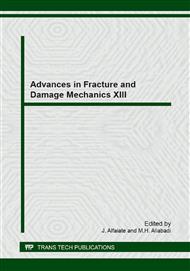p.281
p.285
p.289
p.293
p.297
p.301
p.305
p.309
p.313
Deviations of Microcrack during Propagation in Thin Films of Austenitic Steel and Accompanying Accommodative Processes
Abstract:
The work deals with the transmission electron microscopy (TEM) study of thin films of chromium-nickel Х18Н10 steel. The films were prepared from bulk samples after low cycle fatigue (LCF) tests. Focus was made on the processes accompanying propagation of small microcracks. Particularly, the microstructure changes near the crack tip were analyzed in terms of accommodation processes taking place during crack propagation, such as formation of slip bands, twins etc. The authors conducted crystallographic analysis of the defects formed during crack propagation in correlation with the reasons of their initiation and homogenous length of the slip bands. Thus, the reasons of microcrack deviation from the initial direction were determined. The research has shown that the most convenient microstructure variables in the austenitic crystals of polycrystalline sample, affecting the microcrack deviation, are microstructure, crystallography and the homogenous length of slip bands.
Info:
Periodical:
Pages:
297-300
Citation:
Online since:
September 2014
Authors:
Keywords:
Price:
Сopyright:
© 2015 Trans Tech Publications Ltd. All Rights Reserved
Share:
Citation:


